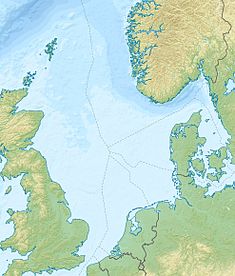Gullfaks is an oil and gas field in the Norwegian sector of the North Sea operated by Equinor. It was discovered in 1978, in block 34/10, at a water depth of 130-230 meters.[1] The initial recoverable reserve is 2.1 billion barrels (330×106 m3), and the remaining recoverable reserve in 2004 is 234 million barrels (37.2×106 m3). This oil field reached peak production in 2001 at 180,000 barrels per day (29,000 m3/d). It has satellite fields Gullfaks South, Rimfaks, Skinfaks and Gullveig.[2]
| Gullfaks | |
|---|---|
 Gullfaks A being completed in Stord | |
| Country | Norway |
| Location | North Sea |
| Block | 34/10 |
| Offshore/onshore | offshore |
| Coordinates | 61°12′54″N 2°16′48″E / 61.215°N 2.280°E |
| Operator | Equinor |
| Partners | Petoro |
| Field history | |
| Discovery | 1978 |
| Start of production | 1986 |
| Peak of production | 180,000 barrels per day (29,000 m3/d) |
| Peak year | 2001 |
| Production | |
| Current production of oil | 39,000 barrels per day (~1.9×106 t/a) |
| Year of current production of oil | 2013 [1] |
| Estimated oil in place | 73 million barrels (~1.0×107 t) |

Platforms
editThe project consists of three production platforms Gullfaks A (1986), Gullfaks B (1988), and Gullfaks C (1989).[1] Gullfaks C sits 217 metres (712 ft) below the waterline and the height of the total structure measured from the sea floor is 380 metres (1,250 ft),[3] making it taller than the Eiffel Tower. Gullfaks C holds the record [4] of the heaviest object that has ever been moved to another position, relative to the surface of the Earth with a total displacement between 1.4 and 1.5 million tons.[5] The platform produces 250,000 barrels per day (40,000 m3/d) of oil. The Tordis field, which is located 11 kilometres (6.8 mi) southeast of Gullfaks C, has a subsea separation manifold installed in 2007 which is tied-back to the existing Gullfaks infrastructure.[6][2]
| Installation | Gullfaks A | Gullfaks B | Gullfaks C |
|---|---|---|---|
| Type | Concrete gravity platform | Concrete gravity platform | Concrete gravity platform |
| Function | Drilling, production, storage, accommodation | Drilling, production, accommodation | Drilling, production, accommodation |
| Location | SW part of field | NW part of field | |
| Water depth, metres | 135 | 142 | 216 |
| Fabrication substructure | Norwegian Contractors Stavanger | Norwegian Contractors Stavanger | Norwegian Contractors Stavanger |
| Topsides design | Aker Engineering and Foster Wheeler | Aker Engineering and Foster Wheeler | |
| Substructure weight, tonnes | 340,000 | 173,000 | 370,000 |
| Topside weight, tonnes | 40,000 | 25,000 | 49,000 |
| Accommodation (crew) | 330 | 160 | 300 |
| Legs | 4 | 3 | 4 |
| Cells | 24 | 19 | 24 |
| Storage capacity, barrels | 180,000 | Nil | |
| Well slots | 42 | 42 | |
| Wells | 21 production, 17 injection | 20 production, 13 injection | |
| Throughput oil, barrels per day (bpd) | 245,000 | 150,000 | |
| Water injection, bpd | 4 x 95,000 | 95,000 | |
| Platform installed | 1986 | 1987 | May 1989 |
| Production start | 1987 | 1988 | January 1990 |
| Oil production to | 2 x SPM buoys (8,400 m3/hour) | Gullfaks A | |
| Gas production to | Statfjord C | Statfjord C |
Incidents
editBetween November 2009 and May 2010 a well being drilled from Gullfaks C experienced multiple well control incidents which were investigated by Petroleum Safety Authority Norway and summarized in a report released on 19 November 2010. The report stated that only chance prevented the final and most serious incident on 19 May 2010 from becoming a full-scale disaster. The report also questioned why the Statoil’s probe that was supposed to assess which barriers functioned "and thereby helped to prevent or limit the hazard" did not seem to have been assessed.[8]
On 29, April 2016, a helicopter carrying oil workers crashed while flying from the Gullfaks oil field to Bergen. All 13 people on board were killed.[9]
Geology
editThe reservoir consists of delta sandstones from the Middle Jurassic Brent Group, shallow-marine Lower Jurassic Cook Formation sandstones, and the fluvial-channel and delta-plain Lower Jurassic Statfjord Formation.[1]
See also
editReferences
edit- ^ a b c Petterson, O., Storli, A., Ljosland, E., Nygaard, O., Massie, I., and Carlsen, H., The Gullfaks Field, 1992, in Giant Oil and Gas Fields of the Decade, 1978-1988, AAPG Memoir 54, Halbouty, M.T., editor, Tulsa: American Association of Petroleum Geologists, ISBN 0891813330, pp. 429-446
- ^ a b "Statoil". Archived from the original on 2014-12-20. Retrieved 2013-11-27.
- ^ Structures
- ^ "Heaviest man-made object moved".
- ^ Lindberg, Björn (11 August 2022). "How large is a troll?". INDUSTRIMINNE.NO.
- ^ Amazing Structures, author Michael Pollard Page 34,35
- ^ Oilfield Publications Limited (1985). The North Sea Platform Guide. Ledbury UK: Oilfield Publications Limited. pp. 276–83.
- ^ "summary letter in English" (PDF). Archived from the original (PDF) on 2011-07-26. Retrieved 2011-11-14.
- ^ "Super Puma crash: Helicopter 'showed warning light'". BBC News. 2016-05-01. Retrieved 2024-08-11.
External links
edit- Media related to Gullfaks Oil Field at Wikimedia Commons
- Gullfaks (Statoil website)
- Gullfaks facts and interactive map
- Gullfaks C at Structurae
- Offshore Technology
